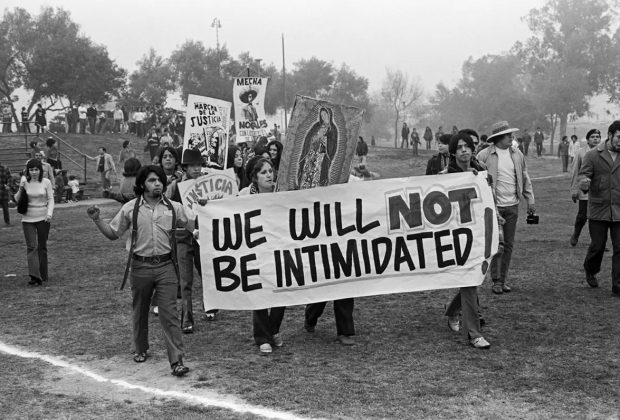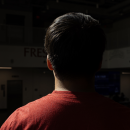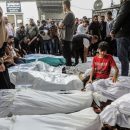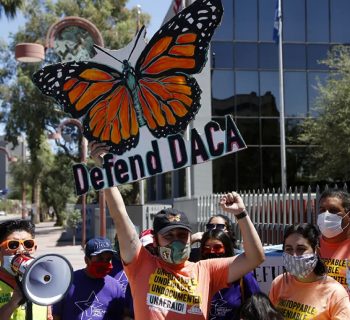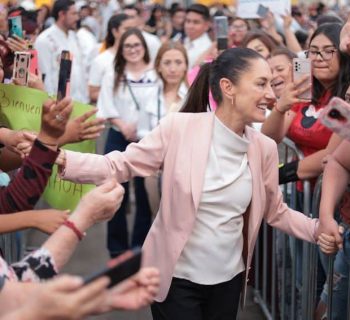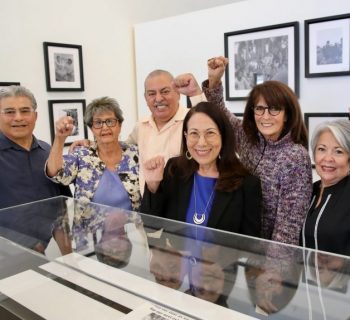Luis C. Garza hosts its World Premiere screening as part of the Special Shorts Program
By Serena Sanchez | Caló News | NOV. 3, 2023 | Photo Courtesy of CauseConnect
Walls littered with art pieces ranging from his own to paintings by David Alfaro Siqueiros, mementos accumulated from his travels and a balcony view of Echo Park barely begins to sum up Luis C. Garza’s meticulously put-together Los Angeles apartment. As we sat across from each other at his dining table with our place mats topped with a healthy slice of flan next to a steaming cup of hot coffee, he laughed at the dull noise coming from the unit above him.
“[It sounds like] they are running an illegal bowling alley up there,” Garza joked.
Throughout his youth, Garza documented the Chicano civil rights movement in Southern California to New York where he captured his own South Bronx neighborhood and demonstrations on women’s rights, as well as his experience at the World Peace Conference in Budapest, Hungary from the 1960s-70s.

Now, having recently turned 80-years-old and on the receiving end of questions about his background and extensive photographs in lieu of the 12-minute documentary, “RAZÓN DE SUR: Luis C. Garza,” directed by Alessandro Gentile which beautifully sums up his life and will be showcased at the Special Shorts Program: Latin/Latinx Film Series in Downtown LA on November 4, the rare Chicano photographer feels nothing but gratitude for the recognition he’s getting.
“It’s a sense of appreciation that’s taken 50 years, but I’m glad that it’s happening,” Garza said. “Because when I pass to the spirit, my work will be my legacy that will live on. My memory will not just be in a tomb, it will be in the history books, it will be written about and it will be referred to. That is an honor. A very humble one that people see in my work now the value of what it is that I did over those decades of work, in film, television and theatrical work, and all the other things that are involved in my life story.”
Early life
Growing up in the South Bronx on the corner of 139th between St. Anne’s and Brook Avenue, Garza was born into a Mexican, bilingual household and a New York City ethnic enclave that he became an expert at navigating.
“It was a whole other world that I grew up in,” Garza said. “I navigated and walked the line between all of these different border areas because everybody’s territorial in New York. I became a chameleon to survive. Mexicano was very unique because there were no others. We had no network, as the other ethnic groups had, for the most part. It’s a very enlightening experience. It’s also part of my photographic work, in terms of documenting and photographing environments.”
It wasn’t until after exiting the military in 1963 that the future photographer ventured across the country to LA in 1965, just two weeks before the Watts Riots, also known as the Watts Rebellion which took place in the Watts neighborhood and held the goal of ending police brutality and discrimination in housing, employment and school systems.
Now navigating the uproar of sex, drugs and Rock n’ Roll and his post-war future, Garza settled in the city and attended a few community colleges before meeting Eduardo, or Ed, Bonilla, a community activist in Lincoln Heights, who launched him into the middle of the 1960s Chicano Movement, or El Movimiento, a social and political movement in the U.S. that worked to embrace a Chicano/a identity while also fighting structural racism.

“I’m parachuted into the middle of everything that’s going on. The school walkouts and the blowouts, and I’m photographing,” Garza said. “Ed is sending me over here and there, to cover this and that. I had never seen so many Mexicans in my life. Coming out of New York, it was just my family, so I come [to LA] and I go, ‘Wow, this is a whole other mundo.’ This energizes me because it’s part of, as I’ve come to realize and educate myself, one of the largest civil rights movements that’s taken place throughout the United States, and also the turmoil in the world. It’s a lot of social unrest.”
Political change for Latinos
Founded in 1967 as a newspaper, La Raza magazine acted as a voice for political, social and economic change for the Latino community, and in the following year, Bonilla introduced Garza to its editors. It was here that the newfound photographer organized people using a camera and regularly contributed to the magazine, which is where he says he found his razón de sur.
“My reason for being,” Garza translates. “It all begins to make sense. The photograph as an instrument for telling the larger story and sharpening your skill as a photographer and a storyteller. I become that amongst my colleagues that I meet, doing the work that we’re doing, photographing and reporting and giving a whole other version of what is going on. It’s an alternative press, it’s an alternate viewpoint. It’s a more expansive viewpoint of who we are, what we are and what matters to us.”
A pivotal person in Garza’s life in more ways than one, Bonilla helps him through the UCLA Upward Bound program, which is what helped him toward his journey as a film/theatre arts student in 1969, all while documenting for La Raza. A few years later, in 1971, via the Soviet Union, Garza attended the World Peace Conference in Budapest, Hungary, where he met Mexican muralist and painter, David Alfaro Siqueiros, well-known for his part in the Mexican Muralism Movement, along with Diego Rivera and José Clemente Orozco.
Their meeting led to In The Eyes of Siqueiros, which has become one of Garza’s most beloved pieces thus far, along with Garza’s involvement in the Conservation of América Tropical, the 40-year-long battle to save and exhibit América Tropical (1932), David Alfaro Siqueiros’ monumental mural on Olvera Street in the center of LA.
Documenting communities
In the 1970s, Garza continued to document his South Bronx and East LA communities and, in the following years, the photographer served as the Public Relations Special Markets Director for Luis Valdez’s live play Zoot Suit, served on the Board of Directors for Plaza de la Raza Cultural Center for the Arts & Education in Lincoln Heights and consulted for the Getty Conservation Institute.
Not even for a moment has he stopped practicing and cultivating his craft as an urban photographer known for his raw and intentional politically-charged work, Garza told CALÓ NEWS, as he reflected on his consistent curiosity that had him looking to other photographers for inspiration. Gordon Parks, an American photographer and composer, Manuel Álvarez Bravo, a Mexican visual artist, Gabriel Figueroa, a Mexican cinematographer and Akira Kurosawa, a Japanese filmmaker and painter, are all artists whose work Garza would absorb and take with him as he grew as a photographer.
“It’s my origins as a budding photographer, in terms of capturing my surroundings and making sense of my surroundings,” Garza said. “The camera is my gyroscope, it gives me a balance and a sense of who I am and how I function within what surrounds me. After a while it’s zen, there’s no separation, you are one with [the camera]. However instantaneous the moment is, it’s the decisive moment, the critical moment, the spiritual moment, the zen moment of capturing an image.”
Along with the act of physically taking a photo, the other half of the process is developing them in the darkroom, which is when he knows whether or not he has captured the instantaneous moment. The transition between these two steps is a deep shift from a technical one to one full of spirituality and emotions, a process Garza compares to giving birth.

“You still don’t know conclusively what the image is going to look like until you get into the darkroom,” Garza told CALÓ NEWS. “That process is a maternal process of conceiving, of putting the light into the film onto paper, which captures the image into the various chemical solutions, as the image then develops and emerges before you. As you look at that image developing before you, you’ve given birth, it’s a birthing experience. It’s a metaphor, but it’s one that I think conveys that sense of a photographer, looking at the work evolving in front of them. That’s my baby.”
Life’s work
With about 8,000 film negatives of his life’s work, the rare Chicano photographer is currently seeking an institution to properly house and archive them. Only having had slight public exposure of his work, with most knowing his work without knowing the artist behind them, such as Sueño (1972) or his photos of Cesar Chavez at the Hilton Hotel in LA in 1974, Garza’s pieces were rarely exhibited before The Other Side of Memory: Photographs by Luis C. Garza. A national tour and book organized and published by Melissa Richardson Banks and CauseConnect: Art That Matters, The Other Side of Memory, released in July, is an exhibition of 66 black-and-white silver gelatin prints carefully chosen from Garza’s mostly unpublished archive.
It was when Richardson Banks reached out to Radium 88 Productions, a Los Angeles-based film production company committed to creating high-quality film and television content, to produce a 5-minute promotional video to promote the book, that the founders, Alessandro Gentile, a director, and Heather Flores, a producer, fell in love with Garza’s story and decided to expand and create “RAZÓN DE SUR: Luis C. Garza.”
“We all realized the potential of [his] story and wanted to take it to a feature-length level and keep building off of what’s there because it’s such a beautiful story,” Gentile said. “His story is about trying to find a home for his work and trying to document that along the way, but also sharing his history, sharing his experiences as a photographer and a photojournalist. He’s a Chicano Forrest Gump. The guy’s at the right place at the right time globally on different. He has all of these cool stories and there’s so much there to tell. We fell in love with Luis. I had a connection with him, we had a connection together, and now we’re trying to evolve and build this. We’re very excited for the future.”
After sitting down with Garza and listening to his story, Gentile wanted to truly document the photographer where he truly flourished–on the streets of LA.
“I thought it would be cool to take him to DTLA, where I was just a fly on the wall as he demonstrated how he would’ve done it back in the day – as if I was documenting him right then when he was younger,” Gentile said. “For me, it was important to capture those elements and also elements in his home to feel the comfort. I would’ve loved to bring a crew, but I felt like I wouldn’t have been able to capture him and his comfortable environment if I had a sound guy, producers, and others.”
Gentile wasn’t the only person involved in the making of RAZÓN DE SUR who felt it was imperative to highlight Garza’s story and work. Raul Pacheco, composer, actor and guitarist for the rock band, Ozomatli, who grew up a Chicano in Boyle Heights, deeply resonated with the photographer’s documentation of East LA, which pushed him to agree to be the composer of the documentary.
“His personal and professional journey and lifelong photo taking for different reasons, different periods of his life, I think is a beautiful artistic story in itself. It’s worth the time to create this piece about him to make a larger film about him to tell more people about Luis Garza and what he’s done in his life as a photographer.”
While this 12-minute documentary is a short one, it feels much longer in the best of ways with Gentile’s excellent direction and ability to condense Garza’s life story into minutes while leaving viewers wanting to know more about the rare Chicano. A longer, feature-length documentary is also in the works, according to the director.
“He was on the scene for specific moments in time and history that I’d like to kind of flesh out and see more present,” Gentile said.
This short film will be shown at the Regal LA Live Theatre in DTLA on November 4 and there are a few takeaways that those behind the film hope the audience leaves with after they’ve seen the documentary on the big screen.

“I feel people will get some hope out of his film,” Gentile said. “That there’s always hope. Even if you take a leap as an artist, you’re not going to hit the rocks. It’s scary. It’s really scary to do what you love, but there’s hope for you.”
Latino photographers
Along with viewers, young Latino photographers and artists who are documenting the world today must hold onto their individual childlike curiosity that drove them to this path in the first place.
“Keep documenting,” Garza said. “Explore, interpret, define, refine your skill set and let your imagination and your curiosity as the forever child. Don’t diminish or undervalue those sensibilities to do what it is that you feel is motivating you to do what you do. Come to understand what’s driving you. Through that exploration, you will find yourself in several ways. My razón de sur is what gave me my sense of who I am today. Be kind to yourself, be generous with yourself.”
Pacheco added, “One thing that’s very important in this film is [Garza’s] commitment to his work, no matter what, whether he makes money or doesn’t, whether he’s successful or not. He realizes that he would be miserable if he wasn’t doing this no matter what. The title translates to ‘his reason for being.’ That’s important for young people who want to be artists, or in any career that young people are choosing to do. To see how your work that is artistic in itself, whether it’s political or not, is worth pursuing.”
Immense gratitude and appreciation don’t begin to cover how Garza feels to not only have a documentary created in his honor but also gain recognition and validation for his decades-long work that has not stopped. At the age of 80, the photographer’s curiosity has never lessened and will remain for years to come as he watches new generations of Latino artists enter the space that he had a huge hand in creating.
“That’s the wonderful result of looking back at what you were doing in those days, organizing, demonstrating and advocating and the fact that that change, that evolution of denial has become acceptance,” Garza said. “[Latinos] have pushed the boundaries, we have opened up the doors and we sit at the table. We’re not only in the kitchen, but we’re at the table. There’s a big difference when you consider where we were 50 years ago without any representation whatsoever. Big difference. To be a part of that and my work reflecting that historical narrative, I am enjoying myself.”
Screening information

If you are interested in learning more about Garza’s work and life story, check out the book, The Other Side of Memory: Photographs by Luis C. Garza. If you are interested in attending the screening of “RAZÓN DE SUR: Luis C. Garza,” on November 4, tickets can be purchased here.

